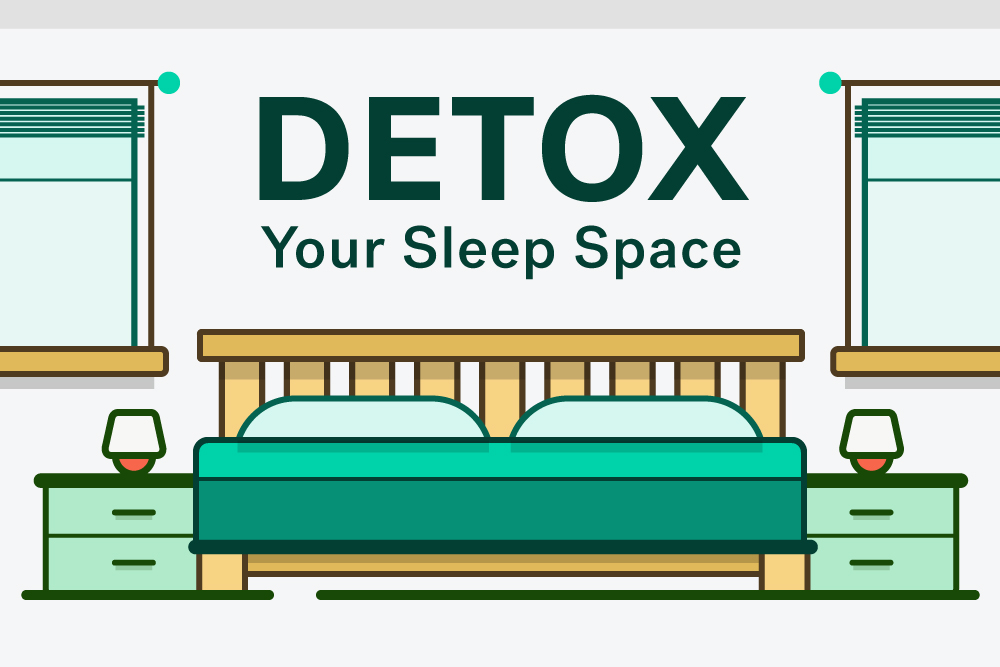We spend a third of our lives in our bedrooms, sleeping (or at least attempting to!). But while you may consider your bedroom a respite from the rest of the world, in actuality harmful chemicals, pollutants, and even radiation from electronic devices can be lurking.
But no need to go sleepless in your Seattle, WA home or apartment. Thankfully, clearing out potential toxins and transforming your bedroom into a healthy haven is fairly simple, whether you’re a renter or a homeowner. Find out how to sleep better by detoxing your bedroom, and you could improve your health, well-being, and quality of sleep.
1. Dismiss those devices
Nothing distracts you from getting to bed at a reasonable hour like a TV, cellphone, or laptop in the bedroom. And according to the National Sleep Foundation, these devices also emit enough light (not to mention low-level radiation) to trick your brain into thinking it’s time to wake up, rather than go to sleep. So the first step when learning how to detox your sleep space is to purge your room of all electronics. Not willing to give up that bedside TV? Unplug it and throw a towel over it before bed. Charge your phone in a different room if possible, or DIY a nightstand designed to hide power cords.
2. Upgrade your mattress
To make sure you’re not breathing in potentially toxic materials every night, take a closer look at your mattress. Many are made with polyurethane foam, a petroleum-based material that emits volatile organic compounds (VOCs), one of the biggest sources of indoor air pollution, according to the Environmental Protection Agency. VOCs can cause respiratory problems and skin irritation, and have even been linked to cancer and other diseases.
Likewise, formaldehyde, commonly used in mattress adhesives, has been linked to asthma, allergies, and lung, nose, and throat cancers. Consider switching to an organic cotton or low-chemical, low-VOC mattress. If your mattress is more than 10 years old, you might really need to upgrade. Before 2004 — when the material was phased out — many mattresses were treated with flame retardants known as PBDEs. Research has linked PBDE exposure to thyroid hormone disruption, memory impairment, and other adverse health effects.
3. Go low- or no-VOC
VOCs are also hiding in some types of wall paint. In addition to harming your health, paint made with VOCs often has such a strong odor that it lingers for weeks, even after it’s completely dried. Next time you do a fresh coat, choose a low- or no-VOC product.
4. Trade up the bed frame
In the market for a new bed frame? Look for one made from sustainable materials like recycled steel, FSC-certified or locally grown wood, and water-based adhesives. Like some conventional mattresses, particleboard and fiberboard frames — and those made with chemical adhesives — can emit potentially toxic formaldehyde fumes.
5. Mind your feng shui
Feng shui experts believe bed placement has a lot to do with your quality of shut-eye. Position your bed so that your head isn’t resting toward the door, and avoid putting your bed against a wall adjacent to the bathroom or the kitchen (the latter is thought to negatively impact health).
6. Make over your nightstand
Excessive clutter can make it difficult to get adequate sleep: A room just feels more calm and serene when it’s tidy. Start your clean sweep with the area closest to your line of sight when you lie down: your nightstand. Dust, corral loose papers and magazines, and lastly, flip the alarm clock around so it faces out and away from the bed. Watching the clock never helps when insomnia strikes.
7. Switch to natural detergent
Slipping into a bed made with freshly washed linens is one of life’s greatest little luxuries. But because we spend so many hours between the sheets, harsh, overly scented detergents can inflame allergies. Switch to laundry products made from natural essential oils and free of phosphates and synthetic dyes and fragrances (or make your own!). Another tip to keep dust mites and allergens at bay? Change your pillowcases every few days and wash pillows regularly.
8. Add plants
Plants are a no-brainer: They instantly brighten any room, absorb pollutants, and improve air quality, which means you can catch better zzz’s. Even if you don’t have a green thumb, there are plenty of low-maintenance options. Pro tip: Japanese royal ferns, spider plants, and aloe vera are among the most useful plants for eliminating VOCs and other toxins.
9. Throw open the shades
As soon as you wake up, open your curtains and let the light flood in. Heat from the sun naturally eliminates extra moisture from the room, decreasing the risk of mold and fungus growth. During warmer months, open windows to let fresh air circulate too.
10. Impose a “no-shoes” rule
Walking on filthy streets and pesticide-treated lawns makes shoes the perfect vehicle for tracking toxins into your home. Even if you don’t have a barefoot policy for the rest of the house, it’s a good idea to start one for the bedroom. Make it a rule to leave all shoes and slippers outside the bedroom door or at least slip them off and carry them to the closet.
What have you done to make your bedroom more Zen-like? Share with us in the comments!


